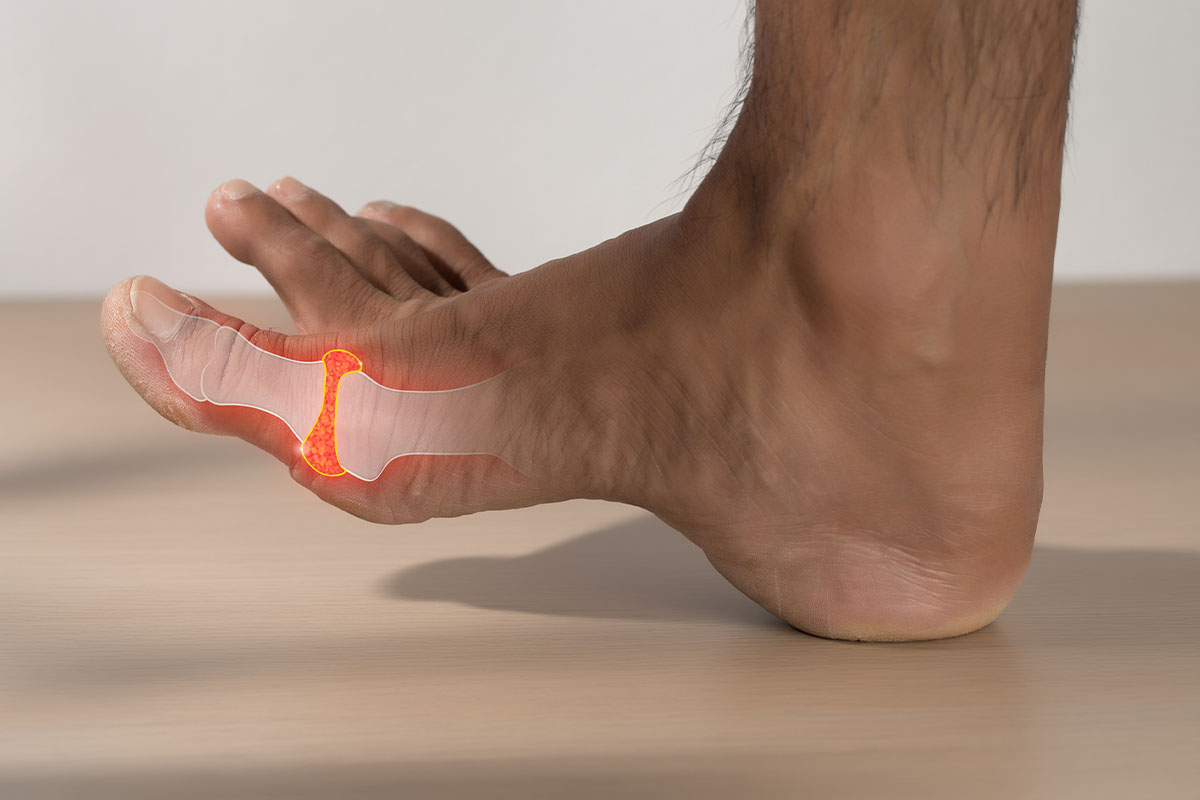Gout is a form of inflammatory arthritis caused by a buildup of uric acid in the body, leading to the formation of urate crystals in the joints. These sharp crystals trigger sudden and intense pain, typically in the big toe, though they can also affect other joints, such as the ankles, knees, and elbows. Gout is known for its flare-ups, where symptoms appear quickly and intensely, often occurring at night. If left untreated, gout can become a chronic condition, leading to persistent joint pain, joint damage, and the formation of tophi—hard deposits of urate crystals under the skin.
What is Gout?

Causes and Risk Factors
Gout occurs when the body produces too much uric acid or cannot effectively eliminate it. Uric acid is a byproduct of the breakdown of purines, naturally occurring substances found in certain foods and beverages. Among the highest purine foods are red meats, seafood and shellfish, beer and liquor. When uric acid levels rise too high, crystals can form in the joints, causing inflammation and pain. Risk factors for gout include:
- Diet: Eating foods high in purines (e.g., red meat, shellfish, alcohol) can increase uric acid levels.
- Genetics: A family history of gout may increase your risk.
- Chronic conditions: Conditions like high blood pressure, diabetes, and kidney disease can contribute.
- Medications: Certain medications, such as diuretics, may increase uric acid levels.
- Age and Gender: Gout is more common in men, especially after age 40, and in postmenopausal women.
Symptoms
- Intense pain: Gout attacks are student and intense. Gout attacks often begin at night, causing excruciating pain, most commonly in the big toe joint. However, other joints such as the ankle, knee, or fingers may also be affected.
- Swelling and redness: The affected joint may become swollen, tender, and red, making it difficult to move.
- Heat: The inflamed joint can feel warm or even hot, making it difficult to move or put pressure on.
- Limited range of motion: As the inflammation worsens, joint stiffness and restricted movement may occur.
Diagnosis
To diagnose gout, a doctor will typically start with a physical examination of the affected joint. They may also perform:
- Blood Tests: Measuring uric acid levels in the blood can help assess the risk of gout, though some individuals with normal levels may still experience gout attacks.
- Joint Fluid Analysis: A sample of fluid is taken from the affected joint and examined under a microscope to detect urate crystals.
- Imaging Tests: X-rays, ultrasound, or CT scans may be used to detect crystal deposits and assess joint damage.
Treatment
Treatment for gout can vary depending on the severity of the flare-ups and the overall health of the patient. Both conservative and surgical options are available:
- Medications: Nonsteroidal anti-inflammatory drugs (NSAIDs), colchicine, or corticosteroids can help relieve pain and inflammation during an acute attack.
- Uric acid-lowering therapy: Medications like allopurinol or febuxostat can help lower uric acid levels in the body to prevent future gout attacks.
- Lifestyle changes: Reducing the intake of purine-rich foods, staying hydrated, and limiting alcohol intake can help prevent gout attacks.
- Dietary modifications: A diet low in purines and rich in fruits, vegetables, whole-grains and low-fat dairy products can reduce the risk of flare-ups.
Surgical Treatment
Surgical treatment for gout is typically considered a last resort when conservative management is no longer effective. In rare cases, gout can lead to severe joint damage or painful formation of tophi—large, painful deposits of urate crystals under the skin. Surgical intervention may be necessary when the tophi interferes with joint function or causes persistent pain. Surgery may involve removing tophi, repairing damaged joints, or in advanced cases, joint replacement.
Tophi removal surgery (debulking surgery) is performed when large, painful deposits of uric acid crystals form under the skin and around the joints. These tophi can cause deformities, restrict joint movement, and lead to chronic pain. During the procedure, the surgeon carefully removes the hardened crystal deposits to relieve pressure and improve mobility.
Joint fusion (arthrodesis) surgery is performed in cases where gout has caused severe joint damage. This procedure involves permanently joining the bones of a joint together to eliminate pain and improve stability. While it reduces flexibility in the affected joint, it can be an effective solution for chronic, debilitating gout.
Joint replacement (arthroplasty) surgery is performed in cases with advanced joint destruction, particularly in the big toe or ankle. This surgery replaces the damaged joint with an artificial implant to restore movement and reduce pain.

Dr. Nicole Cates’ Expertise
As a board-certified foot and ankle surgeon with specialized training in complex deformity correction, I offer both non-surgical and surgical treatment options for patients suffering from gout. Whether you’re experiencing your first gout flare-up or managing chronic symptoms, I will work closely with you to develop a personalized treatment plan aimed at minimizing pain, reducing flare-ups, and preserving joint function.

